
Silver Stream Railway is a heritage railway at Silverstream in the Hutt Valley near Wellington, New Zealand. It regularly operates preserved New Zealand Railways Department locomotives along a restored section of the Hutt Valley Line before a deviation was built in 1954.

The Wairarapa Line is a secondary railway line in the south-east of the North Island of New Zealand. The line runs for 172 kilometres (107 mi), connects the capital city Wellington with the Palmerston North - Gisborne Line at Woodville, via Lower Hutt, Upper Hutt and Masterton.

The Te Aro Extension, also known as the Te Aro Branch, was a short branch line railway in Wellington, New Zealand continuing the Wairarapa Line southwards. It operated from 1893 until 1917.
The Wairarapa Mail was a passenger train operated by the New Zealand Railways Department (NZR) between Wellington and Woodville, continuing on to Palmerston North as a mixed train. It ran from 1909 until 1948 and its route included the famous and arduous Rimutaka Incline.
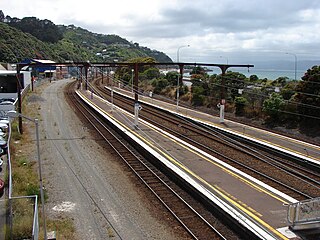
Kaiwharawhara railway station, a former railway station on the North Island Main Trunk and the Wairarapa Line in Wellington in New Zealand, closed in 2013. It was the first station north of Wellington, serving the early suburb of Kaiwharawhara. Prior to its closure it was served by trains operated by Tranz Metro as part of the Metlink network on the Melling Line, the Hutt Valley Line and the Kapiti Line.

Petone railway station is a dual platform, suburban railway station located in the Lower Hutt, New Zealand suburb of Petone. It is on the Hutt Valley section of the Wairarapa Line, 10.5 km (6.5 mi) north of Wellington, and is the junction for the Melling Branch to Melling, which diverges westward from the main line to the north of the station. The station is served by Metlink suburban services, operated by Transdev Wellington, to Wellington, Melling, Taita, Upper Hutt and Masterton.

Ngauranga railway station is a single island platform railway station in the mainly industrial and commercial suburb of Ngauranga on the Wairarapa Line in Wellington, New Zealand. It is on the Wellington suburban rail network and is served by Melling Line trains and some only Hutt Valley Line trains. Wairarapa Connection trains pass this station but do not stop. All trains are run by Transdev as part of the Metlink network.

The Hutt Valley Line is the electrified train service operated by Transdev Wellington on behalf of Metlink on the section of the Wairarapa Line railway between Wellington and Upper Hutt, New Zealand.

The Melling Branch is a railway branch line in the Hutt Valley, north of Wellington, New Zealand. It is part of the national rail network and formerly part of the Wairarapa Line. Until 2010 it was one of only two passenger-only lines in the country, since that year the two being joined by the Onehunga Branch and later by the Manukau Branch.
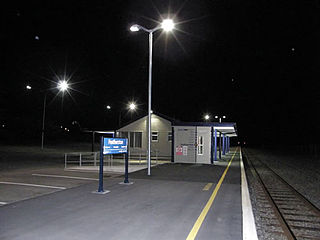
Featherston railway station is a single-platform, urban railway station serving the town of Featherston in the Wairarapa district of New Zealand. The station lies on the Wairarapa Line, and is located between Harrison Street West and Harrison Street East. It is thirty-five minutes journey time to Masterton, or fifty five minutes journey time to Wellington.

Upper Hutt railway station is a suburban railway station serving central Upper Hutt, New Zealand. The station is on the Wairarapa Line, 32.4 km (20.1 mi) north of Wellington, and is served by Transdev Wellington on behalf of the Greater Wellington Regional Council. The station is the northern terminus for the electrified Hutt Valley Line to and from Wellington. The diesel-hauled Wairarapa Connection stops at Upper Hutt on its route between Wellington and Masterton.

Waterloo railway station is a dual-platform suburban railway station located in Lower Hutt, New Zealand, and serving immediately the suburbs of Waterloo, Lower Hutt Central and Woburn. The station stands on the Hutt Valley section of the Wairarapa Line, 15.5 km (9.6 mi) north of Wellington. Trains stopping at Waterloo run to Wellington, Taita, Upper Hutt and Masterton, as well as to points in between. Waterloo serves as a major bus-rail interchange, connecting buses to and from central Lower Hutt, Naenae and Wainuiomata with trains to and from Wellington.
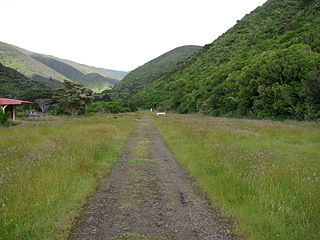
Cross Creek railway station was the base of operations for the Rimutaka Incline, a Fell railway over the Remutaka Ranges, and part of the original Wairarapa Line between Upper Hutt and Featherston in the Wellington region of New Zealand's North Island. The station was between Pigeon Bush and Summit stations on the Wairarapa Line. The station was bypassed when the Rimutaka Tunnel was opened.
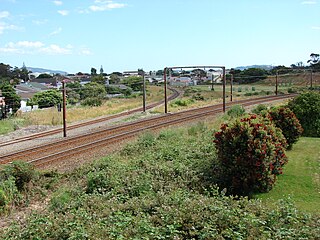
The Gracefield Branch is a 1.6 km long, 3 ft 6 in gauge industrial line from its junction with the Wairarapa Line at Woburn in the Wellington region of New Zealand's North Island to its terminus at the southern end of the Hutt Workshops yard. The line formerly included an additional kilometre of track to Gracefield Freight Terminal, where it connected to a network of industrial sidings in nearby Seaview. Currently its only function is to provide access to the Hutt Workshops.

Manor Park railway station is a suburban railway station serving the suburb of Manor Park in Lower Hutt, New Zealand. The station is located on the Hutt Valley section of the Wairarapa Line, 23.7 km (14.7 mi) northeast of Wellington. The station is served by Metlink's electric multiple unit trains of the "Matangi" FP class. Trains stopping at Manor Park run to Wellington and Upper Hutt. The station has an island platform between two tracks.

Ava railway station is a suburban railway station serving parts of Petone and Alicetown in Lower Hutt, New Zealand. It is located in a residential area bordering these two suburbs, 12.5 km (7.8 mi) north of Wellington, and is part of the Hutt Valley Line. Services are operated by Transdev Wellington on behalf of the Greater Wellington Regional Council. Trains stopping at Ava run to Wellington, Taitā and Upper Hutt.
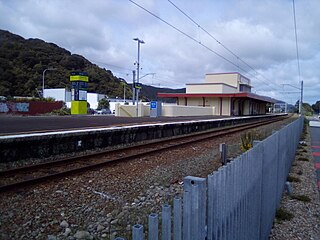
Taitā railway station is a suburban railway station serving Taitā in Lower Hutt, New Zealand. The station is located on the Hutt Valley section of the Wairarapa Line, 20.6 km (12.8 mi) north of Wellington. The station is served by Metlink's electric multiple unit trains of the "Matangi" FP class.

Western Hutt railway station, formerly Lower Hutt, is an intermediate station on the single-track Melling Line in Lower Hutt, New Zealand, It is served by Metlink electric multiple unit trains operated by Transdev Wellington under the Metlink brand.

Te Aro railway station was a station in Wellington, New Zealand, near what is now the corner of Wakefield and Tory Streets. Opened in 1893 it was one of only three stations in the city - the other two were Wellington railway station on Featherston Street, renamed Lambton railway station in December 1908, which was the main New Zealand Railways Department station, and Thorndon railway station off Thorndon Quay, the southern terminus of the private Wellington and Manawatu Railway.

Eketahuna railway station was a station on the Wairarapa Line, a railway line that runs through the Wairarapa region of New Zealand's North Island. Located between the stations of Mangamahoe and Newman, it served the small southern Tararua town of Eketahuna and was one of the few attended stations on the northern section of the line.



















